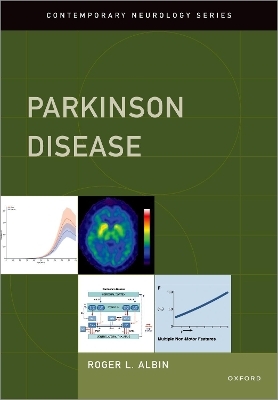
Parkinson Disease
Oxford University Press Inc (Verlag)
978-0-19-084301-4 (ISBN)
Parkinson Disease is a comprehensive introduction to the biology and clinical features of Parkinson disease (PD). This book is aimed at clinicians in training, general neurologists seeking a useful guide to PD, and scientists seeking an overview of clinical aspects of PD. Topics covered include nosology of PD, PD epidemiology, pathology and pathophysiology of PD, and theories of PD pathogenesis. Clinical features, including the many non-motor features, natural history of disease progression, clinical pharmacology, and management of PD receive coverage. Important themes are heterogeneity of PD, the multi-focal nature of PD pathology, the diversity of clinical features, dopaminergic signaling and the impacts of dopaminergic deficiency, the importance of non-motor features, limitations of existing treatment modalities, and the necessity of approaching PD as a multi-system disorder. The description and discussion of the many aspects of Parkinson disease (PD) is dogged by the fact that PD is an ambiguous concept. This book intends to be a useful overview, bridging the gap between general textbooks and specific topical reviews.
Roger L. Albin, M.D. is a graduate of Oberlin College and the University of Pittsburgh School of Medicine. He received clinical and post-doctoral training at the University of Michigan, where his mentors were Anne Young and the late Jack Penney. His primary research interest is the pathophysiology of basal ganglia disorders, including Parkinson disease, Tourette syndrome, and Huntington disease. He is presently Co-Director of the Parkinson Disease & Movement Disorders Division and Director of the Udall Center at the University of Michigan, and Associate Director for Research at the VAAAHS GRECC.
Chapter 1: Definition, History, Nosology, and Classification
Introduction and Definition
Brief History of PD
Nosology and Classification Scheme
Classification Level 1
Classification Level 2
Ambiguities and Future Directions
Conclusion
Chapter 2: Epidemiology
Introduction
Prevalence
Incidence
Mortality
Risk Factors
Implications for Understanding Etiopathogenesis and the Future Burden of PD
Chapter 3: Pathology
Introduction
The Aging Brain
Gross Pathology, Lewy Pathology, and a-Synucleinopathy
Substantia Nigra Pars Compacta Pathology
Idiopathic Lewy Body Disease (iLBD)
The Braak et al. Staging System
Synucleinopathy Outside the Brain
Non-Synuclein Pathologies
Chapter 4: Pathophysiology I - Basal Ganglia Architecture and the Standard Model
Introduction
Basic Basal Ganglia Architecture
The "Standard" Model of Basal Ganglia Pathophysiology
Complexities of Basal Ganglia Architecture
Conclusion
Chapter 5: Pathophysiology II - Neurotransmitter System Dysfunctions
Introduction
Nigrostriatal Dopamine Signaling Functions
Habit Formation and Chunking
Cholinergic Projection System Dysfunctions
Serotoninergic System Dysfunctions
Conclusions and Future Challenges
Chapter 6: Genetics of Parkinson Disease
Introduction
Dominant Forms of PD
Recessive Forms of PD
GBA
PD Genetic Risk Factors
Implications of PD Genetic Research
Chapter 7: Pathogenesis
Neuronal Vulnerability
Alpha-Synuclein
The Prion-Like Hypothesis
Mitochondrial Dysfunction
Oxidative Stress
Endolysosomal Dysfunction
Neuroinflammation
Neuroprotection Trials
Conclusions
Chapter 8: Prodromal Parkinson Disease
Introduction
REM Sleep Behavior Disorder
Observational Studies
REM Sleep Behavior Disorder Cohort Studies
Genetic Cohort Studies
Autonomic Failure
Future Directions
Chapter 9: Clinical Features I - Initial Evaluation
Presentation Features
Nature of Diagnosis and Diagnostic Criteria
History and Examination
Differential Diagnosis
Treatment Responsiveness
Diagnostic Accuracy
Chapter 10: Clinical Features II - Non-Motor Features
Introduction
Cognitive Impairments
Neuropsychiatric Disorders
Sleep Disorders
Pain
Fatigue
Autonomic Disorders
Visual Disorders
Oral Health
Conclusion
Chapter 11: Clinical Features III - Natural History
Introduction
Assessing PD Progression
PD Progression - Clinically Salient Features
Subgroups
Natural History Summary
Continuing Care
End of Life Care
Chapter 12: Pharmacology I - L-Dopa Pharmacokinetics and Pharmacodynamics
Introduction
Dopaminergic Neurotransmission
L-Dopa Pharmacokinetics
L-Dopa Pharmacodynamics
Peak Dose Dyskinesias
Interactions of L-Dopa Pharmacokinetics, Pharmacodynamics, and Disease Progression Summary and Future Directions
Chapter 13: Pharmacology II - Treating Parkinson Disease
Introduction
Using L-Dopa
When the Honeymoon Is Over
L-Dopa Adjuncts
Dopamine Agonists
Cholinergic Agents
Other Symptomatic Therapies
Future Directions
Chapter 14: Surgery
Introduction
Deep Brain Stimulation: Rationale and Possible Mechanisms
Deep Brain Stimulation: Procedures
Deep Brain Stimulation: STN DBS Benefits
Deep Brain Stimulation: GPi DBS Benefits and STN vs GPi DBS
Deep Brain Stimulation: Adverse Events
Lesional Procedures
Cell-Based and Gene Therapies
Future Directions
Coda: Looking Ahead
| Erscheinungsdatum | 17.08.2022 |
|---|---|
| Reihe/Serie | CONTEMPORARY NEUROLOGY SERIES |
| Verlagsort | New York |
| Sprache | englisch |
| Maße | 259 x 184 mm |
| Gewicht | 862 g |
| Themenwelt | Medizin / Pharmazie ► Medizinische Fachgebiete ► Neurologie |
| ISBN-10 | 0-19-084301-2 / 0190843012 |
| ISBN-13 | 978-0-19-084301-4 / 9780190843014 |
| Zustand | Neuware |
| Haben Sie eine Frage zum Produkt? |
aus dem Bereich


